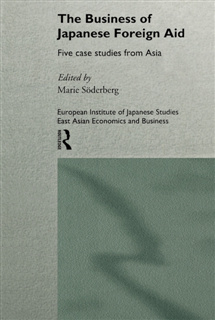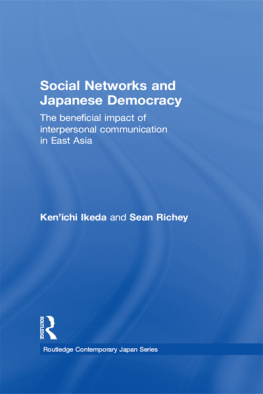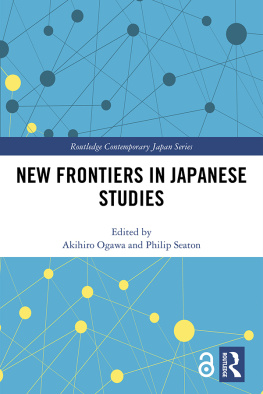
Japanese Influences and Presences in Asia
Nordic Institute of Asian Studies
NIAS Studies in Asian Topics
15. Renegotiating Local Values
Merete Lie and Ragnhild Lund
16. Leadership on Java
Hans Antlv and Sven Cederroth (eds)
17. Vietnam in a Changing World
Irene Nrlund, Carolyn Gates and Vu Cao Dam (eds)
18. Asian Perceptions of Nature
Ole Bruun and Arne Kalland (eds)
19. Imperial Policy and Southeast Asian Nationalism
Hans Antlv and Stein Tnnesson (eds)
20. The Village Concept in the Transformation of Rural Southeast Asia
Mason C. Hoadley and Christer Gunnarsson (eds)
21. Identity in Asian Literature
Lisbeth Littrup (ed.)
22. Mongolia in Transition
Ole Bruun and Ole Odgaard (eds)
23. Asian Forms of the Nation
Stein Tnnesson and Hans Antlv (eds)
24. The Eternal Storyteller
Vibeke Brdahl (ed.)
25. Japanese Influences and Presences in Asia
Marie Sderberg and Ian Reader (eds)
26. Muslim Diversity
Leif Manger (ed.)
27. Women and Households in Indonesia
Juliette Koning, Marleen Nolten, Janet Rodenburg and Ratna Saptari (eds)
28. The House in Southeast Asia
Signe Howell and Stephen Sparkes (eds)
29. Rethinking Development in East Asia
Pietro P. Masina (ed.)
Japanese Influences and Presences in Asia
Edited by
Marie Sderberg and Ian Reader
Nordic Institute of Asian Studies NIAS Studies in Asian Topics, No. 25
First published in 2000 by Curzon Press
Published 2013
by Routledge
2 Park Square, Milton Park, Abingdon, Oxon OX14 4RN
711 Third Avenue, New York, NY, 10017, USA
Routledge is an imprint of the Taylor & Francis Group, an informa business
Typesetting by the Nordic Institute of Asian Studies
Nordic Institute of Asian Studies 2000
While copyright in the volume as a whole is vested in the Nordic Institute of Asian Studies, copyright in the individual papers belongs to the authors. No paper may be reproduced in whole or in part without the express permission of author and publisher.
British Library Catalogue in Publication Data
Japanese influences and presences in Asia. - (NIAS studies in Asian topics; 25)
1.Social influence 2.Japanese - Asia
I.Soderberg, Marie II.Reader, Ian
302.1'3'089956'05
ISBN 13: 978-0-700-71110-9 (hbk)
Marie Sderberg and Ian Reader
This book examines a topic that is succinct in title and extremely diverse, complex and even nebulous in terms of conceptualization and actuality: that of Japanese influence and presence in Asia in the present day, by which we mean roughly the latter part of the twentieth century, but with an eye also to the near future. We shall focus more closely on the meanings of this title later but will start by sketching out important areas of interest that condition and colour this study. All the chapters included herein (as well as a number of other papers) were originally presented at a workshop held in Stockholm in August 1996.
Perhaps the most likely and immediate reaction to a book with a title such as this one would be to assume that it is concerned with economics and politics, two arenas widely associated with terms and concepts such as influence, and with interrelationships between or within geographic areas. That a volume on Japanese influence in Asia is likely to emphasize economic issues, with some vestiges of discussion relating to political influence (including foreign aid and foreign aid politics), is readily understandable, given Japan's position as an economic superpower, currently the second largest economy in the world despite recent economic setbacks. Nowhere is this more noticeable than in Japan's immediate geographic Asian hinterland, where its influence and presence are well known and the subject of much comment. On a bilateral level, Japan is the largest donor of foreign aid to many Asian countries. On the multilateral level, Japanese influence over the main regional player, the Asian Development Bank, is considerable. Japan invests heavily and builds factories in many areas of Asia, and the billboards with Japanese company names along the roads from the airports into the major cities of Asian countries bear testimony to this. Even in the most recent period of economic recession and currency crises Japan has featured prominently in discussions about the ways in which the Asian currency and economic crises may be solved.
Indeed, where the interactions between Japan and the rest of Asia but can also be seen in Asian developing countries through, for instance, the 'Look East' policy espoused by the Malaysian government under its Prime Minister Mahathir Mohamad.
On the surface at least this immense economic presence and influence appears to be a counterweight to a weak political presence. Japan's difficulties in establishing balanced relations with her near neighbours and of developing a political influence to match her economic power are of course conditioned and framed by the shadows of the past, particularly the problematic relationship of the earlier half of this century. The Japanese militarism and colonialism of that era constructed a vision of an Asian order which placed Japan in a dominant, not to say condescending, brutal and hierarchic ascendancy over its Asian hinterland. This legacy continues to colour the ways in which other Asian nations perceive
When one examines the influence and presence of Japan in an Asian context, economics and politics are just pieces of a far larger picture: one that is, itself uneven, fragmented and diverse. As shown in the various essays in this book, there are a number of different levels on which Japanese presence and influence may be manifested, from the broader macro cosmic levels of, for example, political diplomacy and macro-zeconomic policies and developmental model s, to the microcosmic levels in which individual Japanese workers, employed by Japanese companies but working overseas in other Asian countries, interact with their host cultures.
The political and economic arenas, important as they might be, are not the only or necessarily the primary areas in which interactions occur and influences are manifested or imbibed. In looking at Japanese presence, for example, we are talking about something that is not just, or primarily, financial or political, but that is essentially material and human. This human presence (which brings with it numerous economic repercussions), is seen equally in the ubiquitous masses of Japanese tourists visiting urban entrepts such as Hong Kong on shopping trips, or beaches in the Philippines and Thailand in search of the sun, hedonism and (occasionally) sexual escapades, as it is in the growing numbers of Japanese managers, employees and their families,: who live and work in Japanese companies operating in different countries of Asia. Whilst the presence of the first of these may be (in terms of the individual tourists themselves) fleeting and transient, the accumulated presence and impact of large numbers of tourists may be enormous, not just at the economic level in terms of the money they bring with them and the tourist industries that develop around them. The impact goes beyond mere financial balance sheets, for tourism has pronounced and often unplanned repercussions resulting in damaging environmental, cultural and social impacts on its host cultures.the economic and that can have long-lasting effects in the Asian countries in which it has developed into a mass industry. We should also note here that the drive to export tourists was a government-inspired one in the 1980s, when the Japanese government (anxious, inter alia, to counteract Japanese trade surpluses with the rest of the world) sought to spread Japanese yen around the world by encouraging their Japanese citizens to go overseas as tourists. The highly successful state-promoted scheme to get ten million Japanese per year to go overseas may thus be seen as a material example of an overseas expansion and extension of Japanese presence and influence, which has had a profound impact on many areas of Asia.











